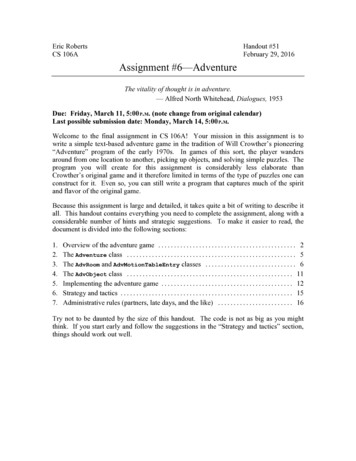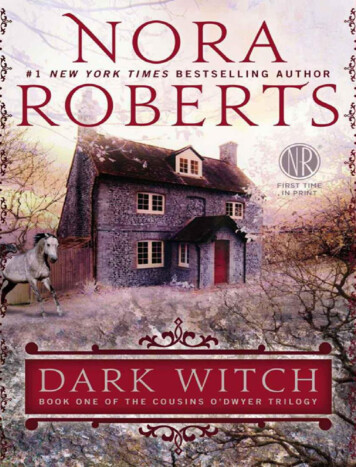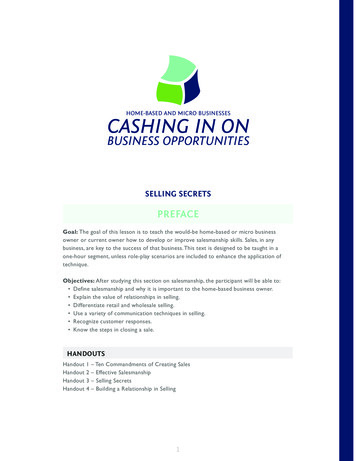
Transcription
Eric RobertsCS 106AHandout #51February 29, 2016Assignment #6—AdventureThe vitality of thought is in adventure.— Alfred North Whitehead, Dialogues, 1953Due: Friday, March 11, 5:00 P.M. (note change from original calendar)Last possible submission date: Monday, March 14, 5:00 P.M.Welcome to the final assignment in CS 106A! Your mission in this assignment is towrite a simple text-based adventure game in the tradition of Will Crowther’s pioneering“Adventure” program of the early 1970s. In games of this sort, the player wandersaround from one location to another, picking up objects, and solving simple puzzles. Theprogram you will create for this assignment is considerably less elaborate thanCrowther’s original game and it therefore limited in terms of the type of puzzles one canconstruct for it. Even so, you can still write a program that captures much of the spiritand flavor of the original game.Because this assignment is large and detailed, it takes quite a bit of writing to describe itall. This handout contains everything you need to complete the assignment, along with aconsiderable number of hints and strategic suggestions. To make it easier to read, thedocument is divided into the following sections:1.2.3.4.5.6.7.Overview of the adventure game . 2The Adventure class . 5The AdvRoom and AdvMotionTableEntry classes . 6The AdvObject class . 11Implementing the adventure game . 12Strategy and tactics . 15Administrative rules (partners, late days, and the like) . 16Try not to be daunted by the size of this handout. The code is not as big as you mightthink. If you start early and follow the suggestions in the “Strategy and tactics” section,things should work out well.
–2–Section 1Overview of the Adventure GameThe adventure game you will implement for this assignment—like any of the text-basedadventure games that were the dominant genre before the advent of more sophisticatedgraphical adventures like the Myst/Riven/Exile series—takes place in a virtual world inwhich you, as the player, move about from one location to another. The locations, whichare traditionally called “rooms” even though they may be outside, are described to youthrough a written textual description that gives you a sense of the geography. You moveabout in the game by giving commands, most of which are simply an indication of thedirection of motion. For example, in the classic adventure game developed by WillieCrowther, you might move about as follows:In this example, you started outside the building, followed the road up the hill by typingWEST, and arrived at a new room on the top of the hill. Having no obvious places to goonce you got there, you went back toward the east and ended up outside the buildingagain. As is typical in such games, the complete description of a location appears onlythe first time you enter it; the second time you come to the building, the program displaysa much shorter identifying tag, although you can get the complete description by typingLOOK, as follows:From here, you might choose to go inside the building by typing IN, which brings you toanother room, as follows:
–3–In addition to the new room description, the inside of the building reveals that theadventure game also contains objects: there is a set of keys here. You can pick up thekeys by using the TAKE command, which requires that you specify what object you’retaking, like this:The keys will, as it turns out, enable you to get through a grating at the bottom of thestreambed that opens the door to Colossal Cave and the magic it contains.Overview of the data filesLike the teaching machine program in Handout #49, the adventure program you willcreate for this assignment is entirely data driven. The program itself doesn’t know thedetails of the game geography, the objects that are distributed among the various rooms,or even the words used to move from place to place. All such information is supplied inthe form of data files, which the program uses to control its own operation. If you run theprogram with different data files, the same program will guide its players throughdifferent adventure games.To indicate which data files you would like to use, the adventure program begins byasking you for the name of an adventure. To get the adventure game illustrated above,you would begin by typing Crowther, which selects the collection of files associated witha relatively sizable subset of Will Crowther’s original adventure game. For eachadventure, there are three associated data files that contain the name of the adventure as aprefix. For the Crowther adventure, for example, these files are CrowtherRooms.txt, which defines the rooms and the connections between them. Inthese examples, you have visited three rooms: outside of the building, the top of thehill, and the inside of the well house. CrowtherObjects.txt, which specifies the descriptions and initial locations of theobjects in the game, such as the set of keys. CrowtherSynonyms.txt, which defines several words as synonyms of other words soyou can use the game more easily. For example, the compass points N, E, S, and W aredefined to be equivalent to NORTH, EAST, SOUTH, and WEST. Similarly, if it makes senseto refer to an object by more than one word, this file can define the two as synonyms.As you explore the Crowther cave, for example, you will encounter a gold nugget, andit makes sense to allow players to refer to that object using either of the words GOLD orNUGGET.These data files are not Java programs, but are instead text files that describe the structureof a particular adventure game in a form that is easy for game designers to write. Theadventure program reads these files into an internal data structure, which it then uses toguide the player through the game.
–4–Your program must be able to work with any set of data files that adhere to the rulesoutlined in this handout. In addition to the three files with the Crowther prefix, thestarter folder also contains file named TinyRooms.txt that contains only three roomswith no objects and no synonyms and a set of three files with the prefix Small that definea much smaller part of the Crowther cave. Your program should work correctly with anyof these files, as well as other adventure games that you design yourself.The detailed structure of each data file is described later in this handout in conjunctionwith the description of the module that processes that particular type of data. Forexample, the rooms data file is described in conjunction with the AdvRoom class.Overview of the class structureThe adventure game is divided into the following principal classes: Adventure—This is the main program class and is by far the largest module in theassignment. This class is yours to write, but—as will be true for all the classes youimplement for this assignment—the public methods are specified in the starter files. AdvRoom—This class represents a single room in the game. This class is also yours towrite. The private methods that decompose parts of the operation are yours to design,but the specification of the public methods used to communicate with other modules isspecified. This class is closely linked with the AdvMotionTableEntry class, which isdescribed in the same section. That class is provided as part of the starter project. AdvObject—This class represents one of the objects in the game. As with theAdvRoom class, you have to implement this class although the public methods arespecified. AdvMotionTableEntry—This class defines a record type that combines a direction oftravel, the room one reaches by moving in that direction, and an optional object thatenables the motion. The definition of this class is extremely simple and is provided inthe starter project.The structure of each of these classes is described in detail in one of the sections thatfollow.Even though the code for these components is substantial, your job is made considerablyeasier by the following properties of the assignment:1. Most of the methods used to communicate among the classes have already beendesigned for you. The public methods in the AdvRoom and AdvObject classes arecompletely specified; all you need to do is implement them.2. The project works from the very first moment that you get it. Each of the classes youneed to design is supplied to you in the form of a .jar file containing several “magicclasses” that implement all of the methods you need. The starter files are written assubclasses of those magic classes; your job is to remove the superclass designationand implement the necessary methods yourself. Providing these magic superclassesmakes it easier to test your code because you can rely on our implementations.
–5–Section 2The Adventure ClassThe main program class is called Adventure and will contain most of the code you haveto write for this assignment. This is the class that opens the data files, assembles the datastructures, maintains the list of words known by the game, interacts with the user, andimplements the various commands. For the most part, you will have the opportunity tofigure out how to decompose the entire operation into reasonably sized pieces and forchoosing what data structures and methods to use in the underlying implementation.The starter file for the Adventure class appears in Figure 2, which includes a definitionfor the Adventure class with an empty body. The implementation of this class isprovided by AdventureMagicSuperclass in the AdventureMagic.jar library thatcomes with the starter folder. As the comments in Figure 2 make clear, your job is totake away the “magic” implementation that we’ve provided and replace it with your owncode. When you finish, your version of Adventure class will extend ConsolePrograminstead of AdventureMagicSuperclass and contain complete implementations of a runmethod along with any private methods and instance variables you need.The Adventure program has the following responsibilities:1. Ask the user for the name of an adventure, which indicates what data files to use2. Read in the data files for the game into an internal data structure3. Play the game by reading and executing commands entered by the userUnderstanding how to implement these aspects of the game, however, requires you tolearn more about the AdvRoom and AdvObject classes, which are described in the nexttwo sections. Section 5 then returns to the question of how to implement the Adventureclass, which represents the lion’s share of the assignment.Figure 2. The Adventure.java starter file
–6–Section 3The AdvRoom and AdvMotionTableEntry ClassesThe AdvRoom class represents an individual room in the game. Each room in the game ischaracterized by the following properties: A room name, which is a string used to identify the roomA short description, which is a one-line string identifying the roomA long description, which is a list of lines describing the roomA list of objects contained in the roomA flag indicating whether the room has been visitedA motion table specifying the exits and where they leadThe AdvRoom stores this information in its private data structure and then makes thatinformation available to clients through the public methods exported by the class. Thesemethods are included in the starter file but are commented out, ensuring that the programuses the implementations from the superclass. When you are ready to write the code forthe AdvRoom class, you need to remove the extends clause from the class definition,uncomment each of the methods, and then fill in the necessary code. As with theAdventure class itself, you will need to define instance variables and helper methods tocomplete the class implementation.The methods in the AdvRoom class are described in detail in the comments in the starterfile. For easier reference, a short description of each method appears in Figure 3.Figure 3. Methods in the AdvRoom class
–7–The rooms data fileAs in the teaching machine example from Handout #49, the information for theindividual rooms is not part of the program but is instead stored in a data file. One ofyour responsibilities in implementing the AdvRoom class is to write the static methodreadRoom(rd), which creates a new AdvRoom object by reading that description from therooms file for that adventure. At first glance, the data files for rooms look almost exactlylike those for the teaching machine. For example, TinyRooms.txt looks like this:The only obvious differences between the external file format for the teaching machineand the adventure game are1. The rooms are named rather than numbered, which makes the files easier to write.2. The title line is missing (the TeachingMachine.java program requires a course titleon the first line).3. Each of the entries for an individual room includes a short description (such asOutside building or End of road) as well as the extended description.These changes are in fact extremely minor. Even in the teaching machine example, thequestion numbers were stored in a map so that the course designer could choose anyconvenient numbering scheme. Storing room names in a map is just as easy.In thinking about an adventure game—particularly as the player, but also as theimplementer—it is important to recognize that the directions are not as well-behaved asyou might like. There is no guarantee that if you move from one room to another bymoving north, you will be able to get back by going south. The best way to visualize thegeographic structure of an adventure game is as a collection of rooms with labeled arrows
–8–that move from one room to another, as illustrated by the following diagram of theconnections defined in TinyRooms.txt:Extensions to the connection structureIf the adventure program allowed nothing more than rooms and descriptions, the gameswould be extremely boring because it would be impossible to specify any interestingpuzzles. For this assignment, you are required to implement the following features thatprovide a basis for designing simple puzzles that add significant interest to the game: Locked passages. The connection data structure must allow the game designer toindicate that a particular connection is available only if the player is carrying aparticular object. That object then becomes the key to an otherwise locked passage. Inthe rooms file, locked passages are indicated by including an object name after a slash. Forced motion. If the player ever enters a room in which one of the connections isassociated with the motion verb FORCED, the program should display the longdescription of that room and then immediately move the player to the specifieddestination without waiting for the user to enter a command. This feature makes iteasy to display a message to the player.Both of these features are illustrated by the segment of the SmallRooms.txt data fileshown in Figure 4 on the next page. If the player is in the room named OutsideGrateand tries to go down, the following two lines in the connection list come into play:DOWNDOWNBeneathGrate/KEYSMissingKeysThe first line is used only if the player is carrying the keys. In this case, a player holdingthe keys would move into the room named BeneathGrate. If the player is not carryingthe keys, the DOWN command takes the user to room named MissingKeys. Because themotion entries for the room named MissingKeys include the verb FORCED, the programprints out the long description for that room and then moves the player back to the roomnamed OutsideGrate, as shown in the following sample run:
–9–Figure 4. Excerpt from SmallRooms.txtIt is possible for a single room to use both the locked passage and forced motion options.The CrowtherRooms.txt file, for example, contains the following entry for the room justnorth of the curtain in the building:The effect of this set of motion rules is to force the user to room named Curtain2 if theuser is carrying the nugget and to the room named MissingTreasures otherwise. Whenyou are testing your code for locked and forced passages, you might want to payparticular attention to the last eight rooms in the CrowtherRooms.txt. These roomsimplement the shimmering curtain that marks the end of the game.The final special case you need to implement is some way to stop the program. Themotion entries in the rooms file include a special room name EXIT, which is used to stopthe game. Your code needs to check for EXIT and then arrange to stop the game loop.The AdvMotionTableEntry classThere are several possible strategies one might have chosen to represent the table ofconnections in each room to its neighbors. In this assignment, you should store the roomconnections as a list each of whose elements is an instance of AdvMotionTableEntry.The complete definition of this class is included with the starter file and appears in full in
– 10 –Figure 5. You could easily have designed this class yourself, but we decided to give it toyou to make the assignment a bit simpler.Figure 5. The AdvMotionTableEntry class
– 11 –Section 4The AdvObject ClassThe AdvObject class keeps track of the information about an object in the game. Theamount of information you need to maintain for a given object is considerably less thanyou need for rooms, which makes both the internal structure and its externalrepresentation as a data file much simpler. The entries in the object file consist of threelines indicating the word used to refer to the object, the description of the object thatappears when you encounter it, and the name of the room in which the object is initiallylocated. For example, the data file SmallObjects.txt looks like this:This file indicates that the keys start out in the room named InsideBuilding, the lampinitially resides in the room named BeneathGrate, and the rod can be found in the roomnamed DebrisRoom. The entries in the file may be separated with blank lines forreadability, as these are here; your implementation should work equally well if theseblank lines are omitted.The objects, of course, will move around in the game as the player picks them up ordrops them. Your implementation must therefore provide a facility for storing objects ina room or in the user’s inventory of objects. The easiest approach is to use a List, whichmakes it easy to add and remove objects. Short descriptions of the methods in theAdvObject class appear in Figure 6.Figure 6. Methods in the AdvObject class
– 12 –Section 5Implementing the Adventure GameAs noted in the introduction to this assignment, implementing the Adventure classrepresents the lion’s share of the work. Before you start in on the code, it will simplifyyour life considerably if you spend some time thinking about the data structures you needand what the overall decomposition looks like. The most relevant model is the teachingmachine described in Handout #49, but there are several important differences that youwill have to keep in mind.The run method for the Adventure class must execute each of the following steps:1. Ask the user for the name of an adventure, which indicates what data files to use2. Read in the data files for the game into an internal data structure3. Play the game by reading and executing commands entered by the userAsking the user for the name of the adventure is nothing more than a call to readLine.The other two phases are substantial enough to warrant subsections of their own.Reading in the data filesOnce you have the name of the adventure, the next phase in the program is to read in thedata files that contain all the information necessary to play the game. As noted in thesection entitled “Overview of the data files” on page 3, every adventure game isassociated with three text files whose names begin with the adventure name. Forexample, if the adventure name is Crowther, these files are named CrowtherRooms.txt,CrowtherObjects.txt, and CrowtherSynonyms.txt. The formats of the first two fileshave already been described in the discussion of the AdvRoom and AdvObject classes.Each of those classes, moreover, includes a static method that reads the data for one roomor one object from a BufferedReader. All the Adventure class has to do, therefore, is1.2.3.4.5.6.Open the appropriate file to obtain the BufferedReader object.Create an empty data structure for the rooms or objects, as appropriate.Call AdvRoom.readRoom or AdvObject.readObject to read in a new value.Add the new room or object to your data structure.Repeat steps 3 and 4 until readRoom or readObject returns null.Close the reader.The rooms file must be present in every adventure, and your program should print anappropriate error message if that file is missing. If the objects file is missing—as it is forthe Tiny adventure—your program should simply assume that there are no objects.The only file whose format you haven’t seen is the synonyms file, which is used to defineabbreviations for commands and synonyms for the existing objects. The synonym fileconsists of a list of lines in which one word is defined to be equal to another. TheCrowtherSynonyms.txt file, for example, appears in Figure 7. This file shows that youcan abbreviate the INVENTORY command to I or the NORTH command to N. Similarly, the
– 13 –Figure 7. The CrowtherSynonyms.txt fileuser can type GOLD to refer to the object defined in the object file as NUGGET. If thesynonyms file doesn’t exist, your program should assume that there are no synonyms.The hard part of reading the data files is not the operational aspects of reading lines froma data file and dividing the line up into pieces, but rather designing the data structure intowhich you store the data. Each line of the synonyms file consists of two strings separatedby an equal sign. You can separate the string into its component pieces in any of anumber of ways, but you also have to figure out how you want to store the information sothat it is useful to the program.Executing commandsOnce you have read in the data, you then need to play the game. The user will alwaysstart in the first room specified in the rooms file and then move around from room toroom by entering commands on the console. The process or reading a command consistsof the following steps:1. Read in a line from the user.2. Break the line up into a verb representing the action and an object (if specified)indicating the target of that action. In the game you have to write, the object isrelevant only for the TAKE and DROP commands, but your extensions might add otherverbs that take objects as well. In this phase, you should make sure to convert thewords to uppercase and check the synonyms table to ensure that you’re working withthe canonical form of each word. For example, if the user types RELEASE GOLD, yourprogram should decide that the verb is DROP and the object is NUGGET.3. Decide what kind of operation the verb represents. If the word appears in the motiontable for some room, then it is a motion verb. In that case, you need to look it up inthe motion table for the current room and see if it leads anywhere from the currentroom. If it isn’t a motion verb, the only legal possibilities (outside of any extensionsyou write) is that it is one of the six built-in action verbs described in Figure 8: QUIT,HELP, LOOK, INVENTORY, TAKE, and DROP. If you have an action verb, you have to calla method that implements the appropriate action, as outlined in the following section.In any other case, you need to tell the user that you don’t understand that word.
– 14 –Figure 8. The built-in action verbsIn previous versions of this assignment, I’ve insisted that students implement the actionverbs be defining commands as a Java class hierarchy, much as you did with the buttonsin the ImageShop application. While that strategy is more extensible, it is clearly overkillfor an assignment with just six commands. It’s much easier to use a cascading ifstatement that first checks if the verb is "QUIT", then checks to see if it’s "HELP", and soon.
– 15 –Section 6Strategy and TacticsEven though the adventure program is big, the good news is that you do not have to startfrom scratch. You instead get to start with a complete program that solves the entireassignment because each of the classes you need to write is implemented as a subclass ofa library stub that performs all of the necessary functions. Your job is simply to replacethe stubs with code of your own. In your final version, the implementation of Adventureshould be a direct subclass of ConsoleProgram and the AdvRoom and AdvObject classesshould not specify a superclass at all.The following suggestions should enable you to complete the program with relativelylittle trouble: Start as soon as possible. This assignment is due in less than two weeks, which is arelatively short amount of time for a project of this size. If you wait until the daybefore this assignment is due, it will be impossible to finish. Get each class working before you start writing the next one. Because the starterproject supplies magic superclasses that implement each of the classes you need towrite, you don’t have to get everything working before you can make useful progress.Work on the classes one at a time, and debug each one thoroughly before moving on tothe next. My suggestion is to start with AdvObject and AdvRoom, and then to move onto the more difficult implementation of Adventure itself. Use the smaller data files for most of your testing. Don’t try to test your code on theCrowther data files. These files take time to read in and are complicated only becauseof their scale. The Tiny data files are appropriate for the basic functionality, and theSmall data files have examples of the required features. When you finish yourimplementation, it makes sense to try the larger data files just to make sure everythingcontinues to work in the larger context. Test your program thoroughly against the handout, the web demos, and the versionthat uses the magic superclasses. When you think you’ve finished, go back throughthe handout and make sure that your program meets the requirements stated in theassignment. Look for special cases in the assignment description and make sure thatyour program handles those cases correctly. If you’re unsure about how some caseshould be handled, play with the version containing the stub code and make sure thatyour program operates in the same way.
– 16 –Section 7Administrative RulesProject teamsAs on the last several assignments, you are encouraged to work on this assignment inteams of two, although you are free to work individually as well. Each person in atwo-person team will receive the same grade, although individual late-day penalties willbe assessed as outlined below.GradingGiven the timing of the quarter, your assignment will be evaluated by your section leaderwithout an interactive grading session.Due dates and late daysAs noted on the first page of this handout, the final version of the assignment is due onFriday, March 11. You may use late days on this assignment, except that the days arenow calendar days rather than class days (which makes sense given that class isn’tmeeting). If you submit the assignment by 5:00 P.M. on Saturday the 12th, you use up oneday late, and so forth. All Adventure assignments, however, must be turned in by5:00 P.M. on Monday, March 14, so that your section leaders will be able to grade it.On the Adventure assignment, late-day accounts are calculated on an individual basis.Thus, if you have carefully saved up a late day but your partner has foolishly squanderedhis or hers early in the quarter, you would not be penalized if the assignment came in onThursday, but your partner would.
"Adventure" program of the early 1970s. In games of this sort, the player wanders around from one location to another, picking up objects, and solving simple puzzles. The program you will create for this assignment is considerably less elaborate than Crowther's original game and it therefore limited in terms of the type of puzzles one can .










